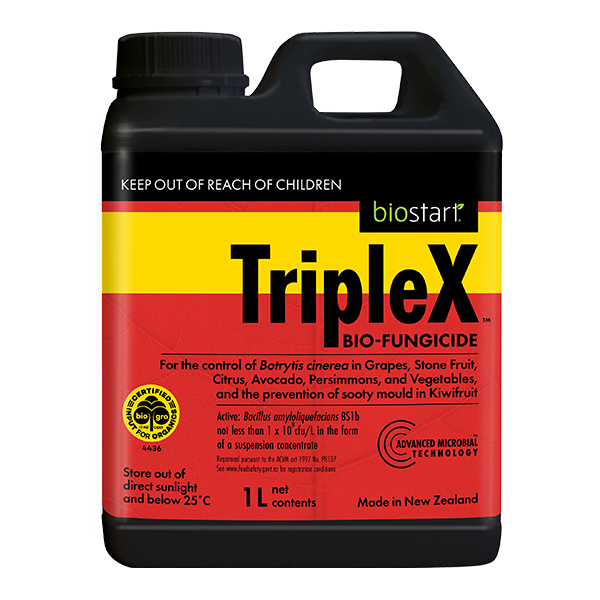Kiwifruit
At Biostart, we support kiwifruit growers with biostimulants that activate soil and plant microbes that stimulate good root growth, nutrient uptake and resilience against disease – resulting in bigger and better yields. We also have solutions for Sooty Mould, Sclerotinia and Armillaria.
Mycorrcin
Improve soil health by activating beneficial soil microbes and mycorrhizal fungi. Certified organic version available.
Foliacin
Foliar spray for improved plant health and resilience. Certified organic version available.
How we can help
You may already know about Triple X and how it can be used for preventing sooty mould, but did you know it is now on the Zespri Crop Protection Standard for the control of Sclerotinia, too?
There is also Terracin, which is on the Zespri Crop Protection Standard for the suppression of Armillaria in kiwifruit orchards.
Then beyond our disease management products, we have a range of biostimulants to help you get the most from your kiwifruit vines. Optimal soil and leaf biology created by the Biostart programme has been shown to lead to faster kiwifruit orchard establishment, higher graft take, increased cane growth and bud numbers, more resilient vines and higher and better-quality yields.
Our biostimulant products are compatible with nutritional and pest and disease control products so can be easily added into your current growing programme.
Tennyson Blake, our Australian Horticulture Manager, visited Seeka’s kiwifruit orchards in Victoria, Australia to see how their trial of Mycorrcin (our biological activator) was progressing. He was able to take these videos showing the improvement Mycorrcin has made on structure, aeration and organic matter content in the soil over the 100 weeks the trial has been running.
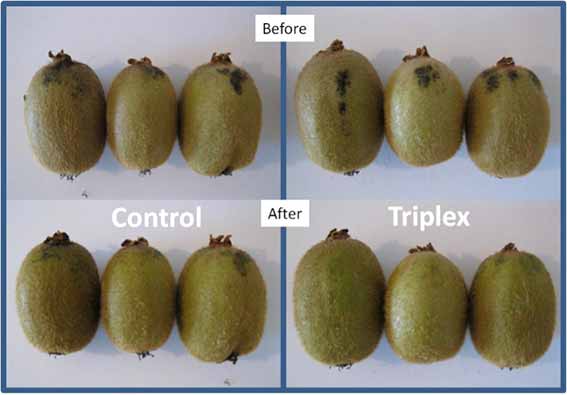
Sooty Mould Infected Fruit StudyKiwifruit with clear symptoms of sooty mould infection were dipped in a diluted TripleX solution (1:200). After 2 minutes in the solution the fruit were gently rubbed and assessed for the remaining sooty mould infection. These trials showed that washing fruit in TripleX allowed the sooty mould to be easily removed from the fruit. The sooty mould could not be easily removed from the fruit dipped in water.
Evidence
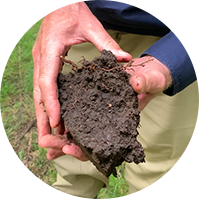 |
Improve soil biology in your kiwifruit orchard This flyer details the results of long-term trials conducted in Bay of Plenty kiwifruit orchards using Mycorrcin, Foliacin, and Digester, and concludes that the resulting improvements in soil biology led to higher vine yields and better-quality fruit. Read more |
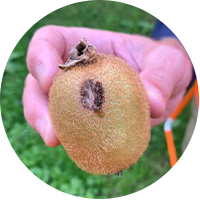 |
Control Sclerotinia over flowering Independent trials were conducted over three seasons (2018/19, 2019/20 and 2021/22) in six Bay of Plenty Hayward Orchards. TripleX reduced the incidence of Sclerotinia by 45%… Read more |
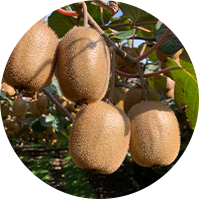 |
Use TripleX to prevent sooty mould TripleX trial results from the Bay of Plenty in 2016. TripleX reduced the incidence of sooty mould in both Hayward and G3 crops in Te Puke and Opotiki. Read more |
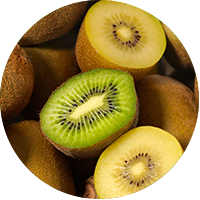 |
Kiwifruit Trial Sheet The Biostart Kiwifruit Programme was undertaken in two Bay of Plenty Hayward kiwifruit orchards by Seeka managers from 2020–2022, resulting increased yield and reduced rejects, while fruit size and quality is maintained. Read more |
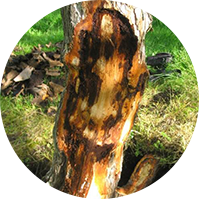 |
Biostart Armillaria Programme Benefits Sheet The benefits of the Biostart Armillaria programme include balancing soil biology, reducing Armillaria induced vine loss, higher yields, sturdier vines with bigger stronger root systems, better soil structure and aeration; and improved canopy health. Read the article |
 |
AgriBusiness July/August Edition 2023 AgriBusiness have written an article reporting on Terracin being registered by ACVM for controlling Armillaria in Kiwifruit Orchards. Read more |
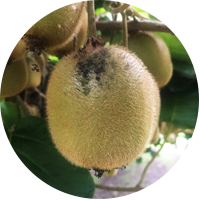 |
TripleX Sooty Mould Case Study An overview of trial work by Dr Jerome Demmer, 5 March 2014. Read more |
 |
The Alexander Family Farm – Testimonial The Alexander Farm grows kiwifruit and uses Mycorrcin and Foliacin to create a more self-sustaining habitat, to be kinder to the environment and save money. Read more |
How to use our products
Yield and quality programme
Our standard kiwifruit programme is designed to increase yield and quality.
| Product | Timing | Application |
|---|---|---|
Mycorrcin |
Prior to planting | Apply Mycorrcin 2 L/ha with weed spray to the planting area. Add 1 L of 1:100 Mycorrcin to the planting hole and plant the tree. Follow up with the standard Mycorrcin program. |
| Early Spring | Apply 6 L/ha/month Mycorrcin sprayed on to the soil. | |
| Growing Season | Apply 2 L/ha/month Mycorrcin sprayed on to the soil. | |
| Autumn | Apply 4 L/ha/month Mycorrcin sprayed on to the soil. | |
Foliacin |
Early growth/first cover spray up to flowering | Dilute 1 L/ha in a minimum of 1000 L of water. Then 1 L/ha every 14-21 days with crop protection sprays and/or nutritional sprays. |
| Fruit set to harvest | Dilute 1 L/ha in a minimum of 1000 L of water. Then apply 1 L/ha every 14-21 days with crop protection sprays and/or nutritional sprays. Aim to make five applications across the season. | |
Digester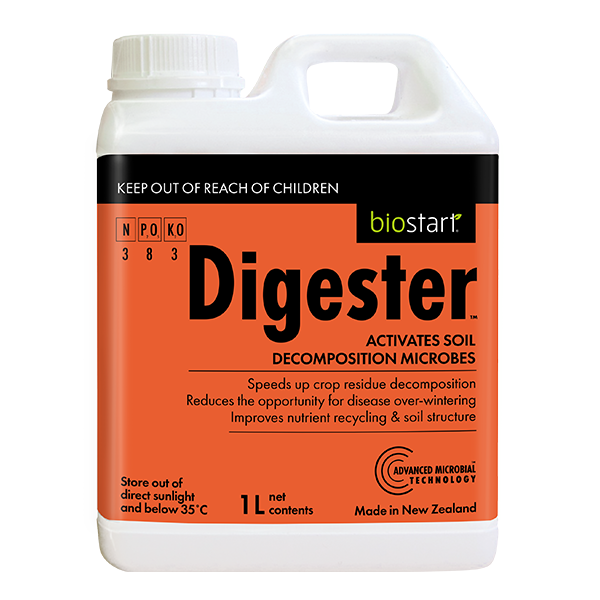 |
Post-pruning or leaf fall; or at mulching | 4 L/ha in a minimum of 200 L of water applied over leaf litter and prunings to the soil. For heavy disease over-wintering, cut-out diseased orchards, compacted or water-logged soil: 6 L/ha in a minimum of 200 L of water. |
Notes
For best results apply Mycorrcin to moist soil and/or water in.
Mycorrcin can be mixed and applied with most herbicides and liquid fertilisers.
Foliacin can be mixed and applied with commonly used fungicides and liquid fertilisers.
In times of high stress increase rate to 2 L/ha.
Organic Biofertiliser Programme
| Product | Timing | Application |
|---|---|---|
Biostart N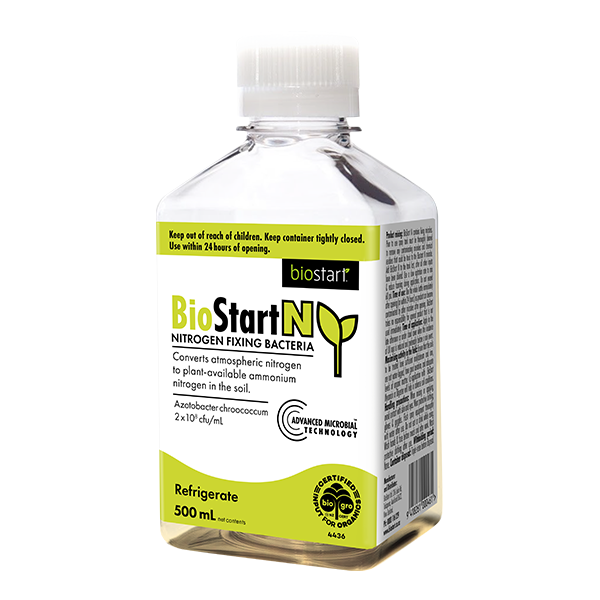 |
Budbreak | Apply 100 mL/ha. |
| Post-flowering | Apply 200 mL/ha. | |
| Post-harvest | Apply 200 mL/ha. |
Armillaria
Armillaria is a in kiwifruit vines is a slow progressing fungal disease that initially restricts production of the vine and eventually results in vine death. Use our biological programme to suppress Armillaria, reset your soil and rejuvenate your orchard. Read more about our armillaria programme and benefits here.
| Product | Timing | Application |
|---|---|---|
Terracin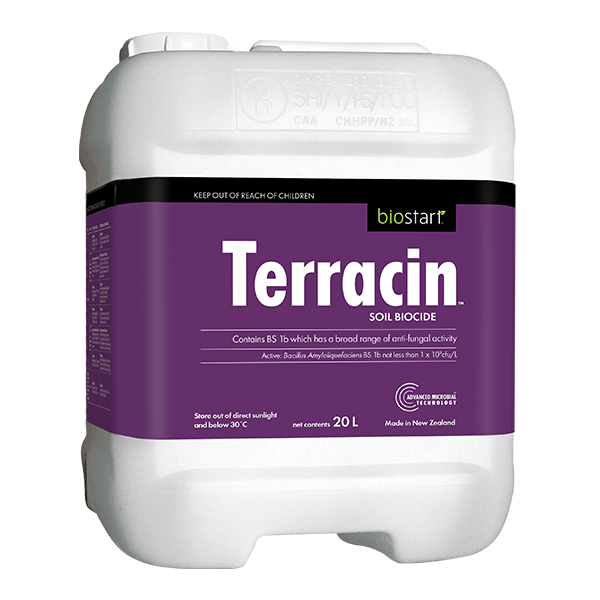 |
Early August |
Whole orchard floor: Apply 20 L/ha Terracin, water rate 2,000 L (1:100 dilution) to the orchard floor. Ensure the lower trunk gets covered with the spray. Repeat programme annually. |
| Early August | Single infected plant programme: Apply to the root zone of the infected vine 20 L of a 1:100 diluted solution of Terracin (1 L Terracin/100 L water). Treat all adjacent vines at the same rate. Ensure the lower trunk gets covered with the spray. Repeat programme annually. | |
Mycorrcin |
Early September, 3–4 weeks after Terracin application | Apply 10 L/ha Mycorrcin in 1,000 L water to the orchard floor. |
| In late November/early December apply | 10 L/ha Mycorrcin in 1,000 L water to the orchard floor. Repeat programme annually. |
Our Sooty Mould programme
Sooty mould is a fungus that causes discolouration of kiwifruit. Use TripleX, which contains the microbe Bacillus amyloliquefaciens Bs1b, to reduce sooty mould’s ability to establish and develop. Read more about TripleX and sooty mould here.
| Product | Timing | Application |
|---|---|---|
TripleX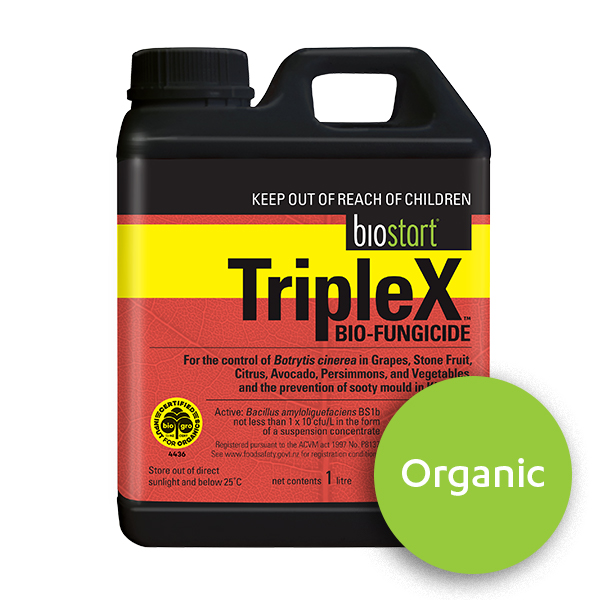 |
When passion vine hoppers and cicadas are active (early January to late March). | Spray 2–3 weekly intervals on to fruit and foliage. Apply a minimum of 3 L/ha diluted in 1,000 L water. A good super wetter (such as DuWett) should be used to ensure thorough fruit and stem coverage as this is where most sooty mould infections are located. |
Notes
TripleX is ACVM registered P8137 and certified organic.
For best results reduce cicada and PVH populations in the orchard and adjacent hedges, use
a clean spray tank, and mix with non-chlorinated water.
Our Sclerotinia programme
The active ingredient in TripleX, the microbe Bacillus amyloliquefaciens Bs1b, reduces Sclerotinia’s ability to establish and develop by colonising the flowers and outcompeting the fungus. Read more here.
| Product | Timing | Application |
|---|---|---|
TripleX |
When kiwifruit (Hayward only) are at 80-90% flowering |
Apply to the flowers and foliage at a dilution rate of 150 mL/100L water to the point of run off. To ensure good coverage, add an approved super wetter/spreader at the recommended label rate and adjust application rates accordingly (call 0800 116 229 if uncertain of compatibility). |
Notes
TripleX is ACVM registered P8137 and certified organic.
For best results reduce cicada and PVH populations in the orchard and adjacent hedges, use
a clean spray tank, and mix with non-chlorinated water.
Ready to get started?
Contact us for personalised advice or find out where you can buy Biostart products:






